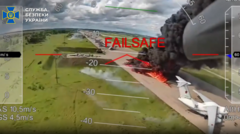Ukraine's "Spider Web" attack on June 1 involved coordinated drone strikes on Russian military airbases, striking deep within enemy territory and demonstrating significant advancements in tactics and technology.
Ukraine Unleashes Ambitious 'Spider Web' Drone Assault on Russian Airbases

Ukraine Unleashes Ambitious 'Spider Web' Drone Assault on Russian Airbases
In a groundbreaking operation, Ukraine launches over 100 drones against key Russian airframes, marking a pivotal moment in ongoing conflict.
On June 1, Ukraine executed a remarkable military operation, known as "Spider Web," launching over 100 drones against Russian airbases, some located thousands of kilometers from Ukrainian borders. This ambitious strategy comes after 18 months of planning and showcases the ingenuity and resourcefulness of Ukraine's military capabilities.
Explosions were reported across multiple time zones in Russia, from Murmansk in the north to the Amur region in the east, highlighting the vast reach of the Ukrainian operation. The Russian Defence Ministry confirmed attacks occurred in five regions: Murmansk, Irkutsk, Ivanovo, Ryazan, and Amur. However, they reported damage only at the airbases in Murmansk and Irkutsk.
Central to the operation's success was Vasyl Maliuk, the head of Ukraine's Security Service (SBU). He revealed that the drones were ingeniously concealed in wooden cabins on lorries. The lorries were driven to strategic locations near Russian airbases, with the drivers unaware of their covert cargo. Videos circulated online depicted drones taking flight from the vehicles, while some drivers attempted to thwart them using stones.
Reports from the Russian Telegram channel Baza indicated that truck drivers had been unknowingly recruited to deliver the wooden cabins, subsequently receiving instructions on where to park. The drivers were astonished when the drones launched from their vehicles.
Ukrainian President Volodymyr Zelensky, who closely oversaw the operation, triumphantly announced the deployment of 117 drones, emphasizing the meticulous year-and-a-half preparation that went into the strikes. He noted that one targeted airbase was located adjacent to an FSB office and claimed the individuals who facilitated the operation were safely removed from Russian territory.
Photos from the SBU show large warehouses filled with the black drones, which military analysts suggest were fashioned through Ukraine’s burgeoning drone manufacturing capabilities. Dr. Steve Wright, a UK drone expert, highlighted the extraordinary nature of the operation, especially the ability to smuggle in and remotely control the drones.
Ukraine reported that the strikes inflicted significant losses on Russia, including damage to 41 strategic bombers, with at least 13 destroyed, though Moscow has been reticent about acknowledging the extent of their losses. Radar imagery confirmed substantial damage to aircraft at both the Olenegorsk and Belaya airbases, including models capable of carrying a variety of long-range missiles.
The operation's total cost to Russia is estimated at around $7 billion, signaling a major blow to its military capacity. While Russian state media quickly downplayed the event, Ukrainians celebrated the audacity of the attack, with Zelensky asserting its historical importance.
In summary, Ukraine's "Spider Web" operation represents a significant leap in tactical warfare, underscoring the ongoing conflict's evolving nature and the shifting dynamics on the battlefield as both sides continue to adapt and innovate.






















